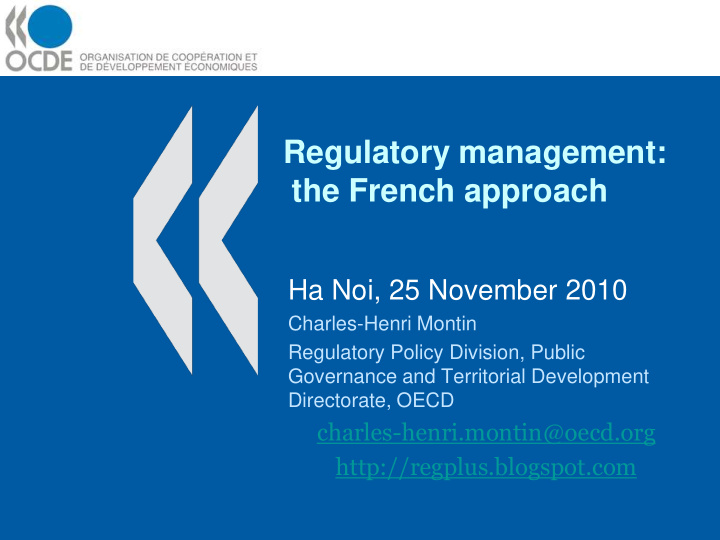



Regulatory management: the French approach Ha Noi, 25 November 2010 Charles-Henri Montin Regulatory Policy Division, Public Governance and Territorial Development Directorate, OECD charles-henri.montin@oecd.org http://regplus.blogspot.com
BR in France (historical background) • A long history of central government and authority, from the kings to the 5th republic • Dirigisme in the economy, then the Central Planning 1947 to 2005 • Specific administrative law and tribunals. Legal tradition in the civil service. Importance of control function and bodies. • Top down consultation of stakeholders (committees of experts or representatives) • Deconcentration and decentralization
The French disease of “normative inflation” • Since 1960: number of laws voted annually: multiplied by 10: Official journal: from 15000 to 23000 pages a year • An unmanageable stock: in 2000 there were 9000 laws and 120.000 décrets. Yearly production: 70 laws, 50 ordinances, 1500 décrets. The length of laws can now go beyond 200 pages • Instability:10% of articles modified in any given year; 120 texts modified the local authority code in the year 2004
Specific traits of the French approach • Includes on a par « control of normative inflation » and «regulatory quality » • Major effort directed to simplification of legal corpus through simplification and codification; repeal of hundreds of old obsolete texts • Guide de légistique for the drafting quality • Very good access to current legislation (see Legifrance site) and simpler official forms and administrative language • Rather formal approach to Consultation: (rather than effectiveness)
Structures and policies Who does what ? – The Secretary General of the Government – The ministry of reform of the State – The network of Senior Officials in charge of BR – The Parliament (now a major player) What BR content? – A BR Charter in each ministry but no overall explicit regulatory policy – Good central planning and monitoring of norm production – No overall consultation policy document – A phase of admin burden reduction, now some RIA practice
Recent trends (from OECD 2010 review) • Public reports (e.g. Conseil d’Etat) on the quality of the law have fuelled promotion of the principles of regulatory quality. Combating proliferation of regulations has led to a reassessment of the changes necessary to improve the rule-making process. • French policy on regulatory governance is linked to the reforms undertaken to modernise the state (RGPP, launched in June 2007). • Increased but not widespread recognition of relevance of effective regulatory governance for economic performance
Recent reforms • Strengthening ex ante impact assessment; – Legal obligation inscribed in a constitutional law 2008, effective 1 Sept 2009 – New methodologies and training of officials • Overhaul of public consultation processes – Clearing the forest of standing commissions – Making flexible use of ICT • Simplification policy which combines legal simplification and a reduction in administrative burdens – 5 Simplification laws including empowerment of government for swift reform
The regulatory cycle in France Alternatives Consultation FLOW RIA The Economy Stakeholders The Administration STOCK Admin burden Access s Simplification
Limits of current policy based on simplification (for discussion) • the simplification process itself contributes to cluttering the legislative agenda • the new laws may not be fully consistent with existing legislation hence complexity/ obscurity / instability • there may a loss of control by Parliament • Implementation difficulties; • lack of transparency: excessive use of internal instructions to provide guidance to services (not legally binding, and often not published)
Conclusions The French approach to regulatory management offers an alternative, perhaps best suited to its historical legacy and current sociological makeup: - Good central control by state authorities, but with corresponding lesser emphasis on consultation and consensus-seeking; - Pride in the quality of the legal corpus; Emphasis on the legal quality and certainty, in support of existing social guarantees, rather than on the search for economic performance and competitiveness; - Growing attention to quality of public services and ease of ‘relations’ with administrative authorities.
For further research The two reports in France: – Conseil d’Etat : « sécurité juridique et complexité du droit » (20 March 2006) : http://www.conseil- etat.fr/ce/rappor/index_ra_li0600.shtml – Senate report by the chairman of the legal committee (Oct 2010) http://www.senat.fr/rap/a10-006/a10-0066.html The OECD Review « Better Regulation in Europe: France 2010 » • Write to charles-henri.montin@oecd.org or consult blog
Recommend
More recommend